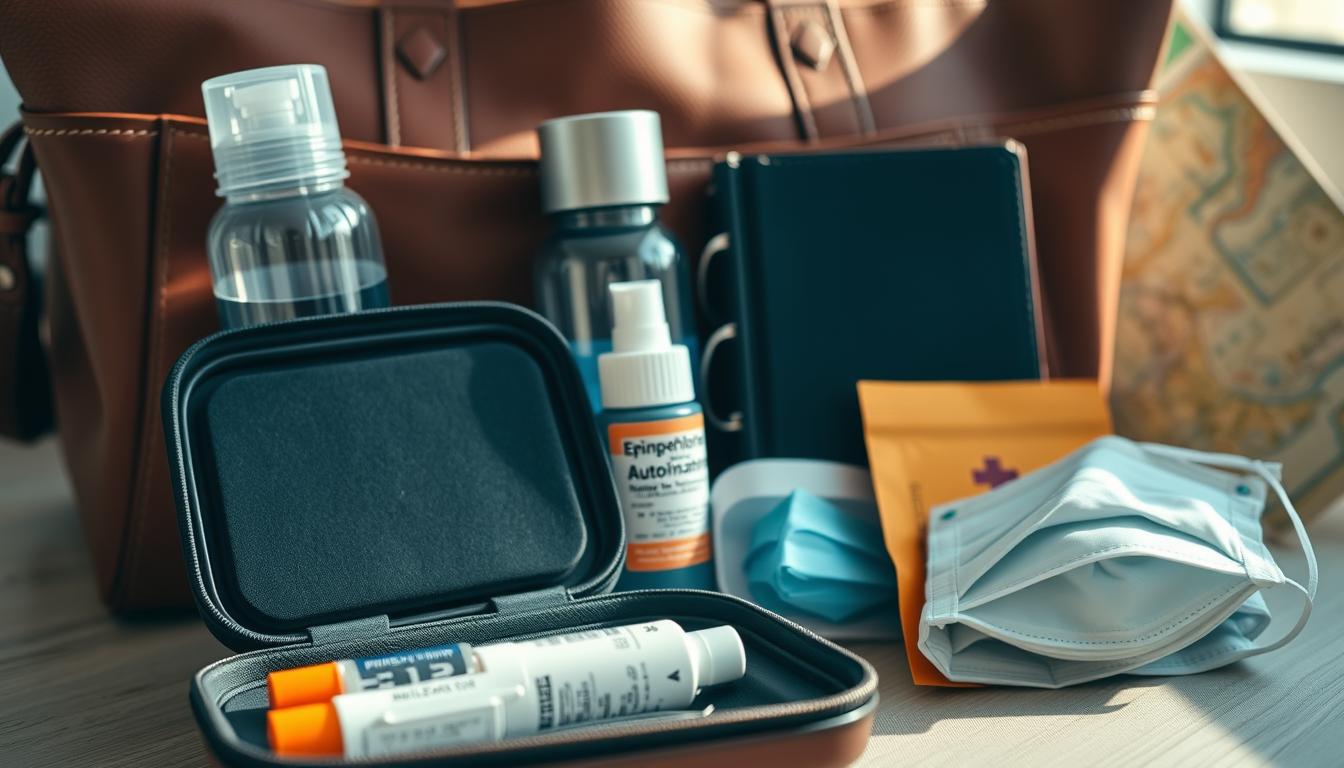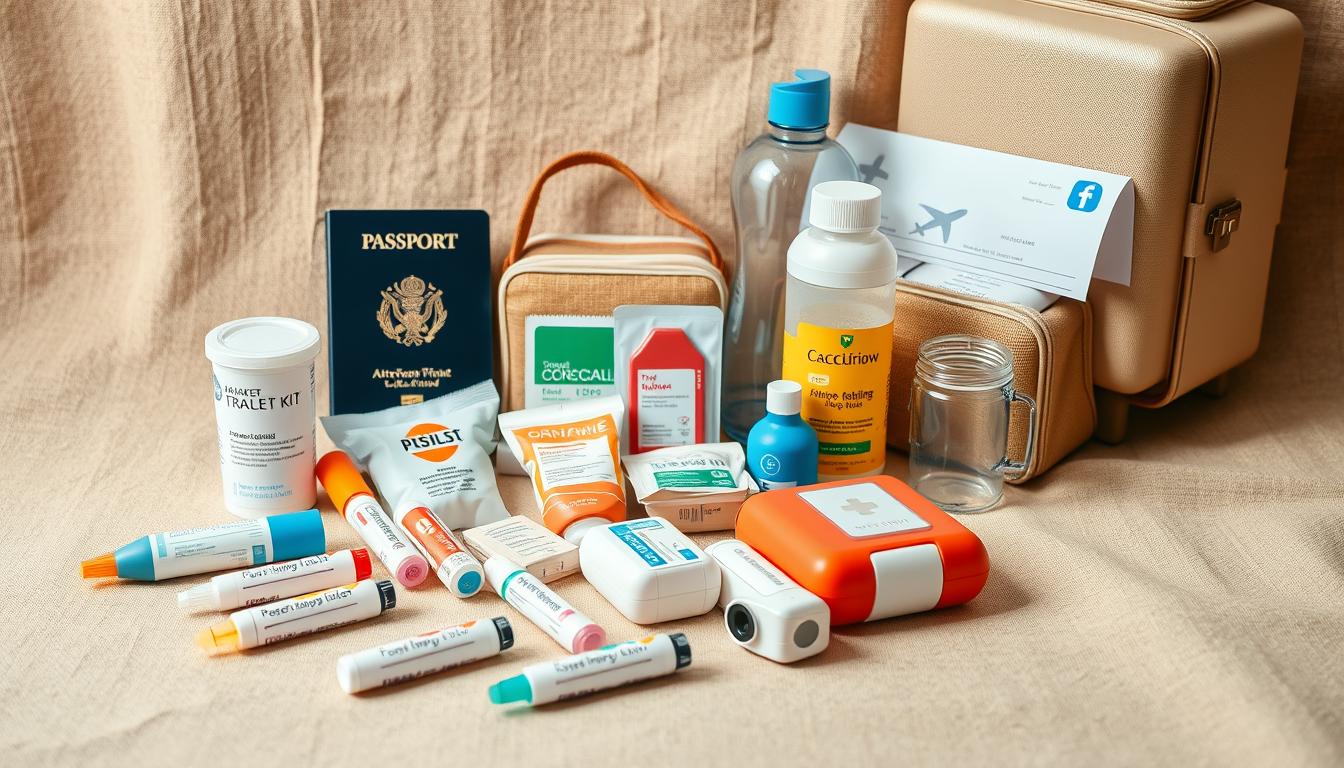Navigating health needs during trips doesn’t have to derail your adventure. Over 20% of people globally manage sensitivities, and having the right coverage can turn stress into confidence. Whether it’s a surprise reaction to local cuisine or unfamiliar environments, the right plan acts like a safety net—letting you explore freely.
Preparation is key. Always consult your physician before leaving and carry a letter from your doctor detailing your needs. Many policies exclude pre-existing conditions unless disclosed upfront, so transparency matters. Specialist plans often cover emergency treatments, medication replacements, and even trip interruptions caused by flare-ups.
We’ve teamed up with experts like Tommy, who’s helped hundreds of travelers craft personalized strategies. This guide breaks down how to compare policies, avoid loopholes, and prioritize your well-being. You’ll learn to spot triggers, decode fine print, and pack smarter—no jargon, just clarity.
Ready to roam without worry? Let’s dive in.
Understanding Allergies and Travel Risks
Exploring new destinations brings adventure, but unfamiliar allergens can surprise even seasoned explorers. Knowing what to watch for helps you stay safe and enjoy every moment.
Identifying Common Sensitivities While Traveling
Food-related reactions top the list, with items like tree nuts, shellfish, and spices causing issues in regional dishes. Environmental factors also play a role—think pollen in springtime Paris or dust in historic hotels.
Seasons and locations dramatically influence exposure. Coastal areas may trigger shellfish sensitivities, while mountain hikes could worsen hay fever. Always check local pollen counts or common ingredients before departure.
Spotting Hidden Triggers Abroad
Menus overseas might not highlight ingredients clearly. Carry translated cards explaining dietary needs to servers—simple phrases like “no peanuts” in the local language prevent misunderstandings.
Notify airlines about your requirements when booking flights. Research clinics near your accommodation, and pack antihistamines alongside your passport. A quick chat with your doctor ensures your action plan covers worst-case scenarios.
Travel Insurance for Allergies: What It Covers
Unexpected reactions shouldn’t dictate your journey—smart preparation lets you stay in control. Over 65% of specialty plans now include emergency repatriation, ensuring you’re never stranded if symptoms escalate. This safety net goes beyond basic care, covering everything from hospital stays to last-minute itinerary changes.
Extended Medical Coverage for Allergic Reactions
Policies often handle costs for sudden flare-ups, like epinephrine injections or IV treatments abroad. A recent survey found 78% of travelers with nut sensitivities avoided financial stress thanks to upfront disclosure. Always share your medical history when purchasing—it unlocks coverage for pre-existing conditions during your trip.
For example, many providers work with airlines to arrange nut-free meals or buffer zones. One client’s severe reaction in Greece led to full reimbursement for their diverted flight and hotel recovery days. Details matter: confirm your plan includes prescription replacements and specialist consultations.
Emergency Assistance and Repatriation Benefits
Round-the-clock hotlines connect you to nurses who coordinate with local hospitals. If stabilization isn’t possible, emergency evacuation brings you home safely. We’ve seen cases where insurers covered $30,000 airlifts for travelers facing anaphylaxis in remote areas.
Double-check if your policy requires pre-approval for certain treatments. Keep digital copies of your documents handy—this speeds up claims if reactions delay return flights. With the right plan, you’ll explore boldly knowing experts have your back.
Preparing for Your Trip with Allergy Safety in Mind
Smart preparation transforms potential worries into peace of mind. A few proactive steps ensure you’re ready to handle surprises while staying focused on the joy of discovery.
Consulting Your Doctor and Securing a Letter of Medical Support
Schedule a checkup 4–6 weeks before departure. Discuss your conditions and ask about adjusting medications for time zones or climate changes. Request a signed letter detailing your diagnosis, required treatments, and emergency protocols. This document helps security personnel understand why you carry epinephrine auto-injectors or antihistamines.
Pack double the medication you think you’ll need. Store half in your carry-on and leave copies of prescriptions with a travel companion. Research local emergency numbers at your destination—save them in your phone and write them on a card tucked into your wallet.
Establishing an Allergy Action Plan
Create a step-by-step guide tailored to your needs. For example: “If I experience swelling after eating unfamiliar foods, take 50mg of diphenhydramine and contact clinic XYZ.” Translate key phrases like “I have a shellfish allergy” into the local language using reliable apps.
Share your plan with travel partners and hotel staff. Practice using emergency medications with a friend—confidence matters during stressful moments. One traveler avoided hospitalization in Tokyo by handing their translated action plan to a pharmacist, who quickly provided the right treatment.
Navigating Airline Policies and In-Flight Precautions
Flying with sensitivities requires extra planning, but modern carriers increasingly accommodate diverse needs. Over 80% of major airlines now offer allergen-friendly protocols—if you know how to activate them. Let’s simplify the process so you can board confidently.
Start Early: Notify Airlines at Booking
Contact your carrier 48+ hours before departure. Many companies like Delta and Emirates create nut-free buffer zones or substitute snacks upon request. Provide specifics: “I require a peanut-free row” holds more weight than a general alert. Follow up with an email confirmation to lock in accommodations.
Decoding Meal Options and Hidden Risks
Even “safe” in-flight meals might contain traces of tree nuts or cross-contact during prep. Ask for ingredient lists in advance—some airlines label dishes as “allergen-controlled.” Pack non-perishable snacks as backup. One traveler avoided a reaction on a 10-hour flight by bringing sealed energy bars from home.
| Airline | Nut Policy | Special Meal Request Deadline |
|---|---|---|
| Delta | No peanuts on request | 48 hours pre-flight |
| Emirates | Nut-free buffer zones | 24 hours pre-flight |
| Qantas | Alt snacks available | 72 hours pre-flight |
Medication Access Made Simple
Carry a letter from your doctor explaining why you need epinephrine or antihistamines. TSA allows larger liquid medications with proper documentation. Store doses in original packaging with clear labels. Flight attendants can refrigerate meds if needed—just ask politely during boarding.
Remember: Crews worldwide train to handle medical emergencies. A family flying to Tokyo alerted staff about their child’s egg allergy, prompting the pilot to make an announcement asking passengers not to open egg-based snacks. Proactive communication turns the cabin into a safer space.
Comparing Specialist Policies and Providers
Choosing the right protection starts with understanding how providers differ. Medical Travel Compared highlights that coverage for sensitivities varies wildly—some plans exclude common triggers entirely. We’ve seen clients save hundreds by comparing quotes side-by-side and asking pointed questions.
Evaluating Coverage for Pre-Existing Conditions
Always share your full medical history when requesting quotes. Many plans automatically exclude pre-existing issues unless declared upfront. One traveler with a shellfish sensitivity avoided denied claims by submitting their doctor’s letter during application.
Look for policies specifying coverage for:
- Emergency epinephrine injections
- Hospital stays due to reactions
- Trip cancellations caused by flare-ups
Tailoring Policies for Severe Allergies
Severe cases often require add-ons like airlift coverage. While these increase costs slightly, they’re lifesavers in remote areas. For example, SafetyWing’s Explorer Plan covers $250,000 in evacuation fees—critical if local hospitals lack specialists.
| Provider | Pre-Existing Condition Coverage | Severe Reaction Benefits |
|---|---|---|
| Allianz | With medical screening | Up to $1M evacuation |
| World Nomads | Excluded by default | $300/day hospital cash |
| SafetyWing | Available as add-on | 24/7 telemedicine |
Set reminders to review your policy’s details annually—coverage limits often change. A client discovered their plan dropped anaphylaxis protection after a renewal date, prompting a swift switch. Your health deserves this attention to detail.
Practical Tips for Managing Allergies on the Road
Staying safe abroad starts with smart packing and knowing your resources. Follow these tested strategies to handle surprises calmly and keep your journey on track.

Carrying Essential Medications and Documentation
Pack two sets of medications—one in your carry-on, another in checked luggage. Keep everything in original packaging with pharmacy labels intact. This speeds up security checks and helps foreign pharmacists identify doses quickly.
| Must-Have Items | Purpose | Backup Plan |
|---|---|---|
| Epinephrine auto-injectors | Emergency response | Store in temperature-controlled pouch |
| Doctor’s letter | Explains medical needs | Digital copy in cloud storage |
| Translated allergy cards | Communicate food restrictions | Use photo app for instant translation |
Spotting Medical Facilities and Pharmacies at Your Destination
Bookmark emergency clinics using apps like First Aid Red Cross before arrival. Ask hotel staff for local pharmacies that stock your specific antihistamines. Always verify opening hours—some close midday in European cities.
If a food allergy reaction occurs:
- Use emergency meds immediately
- Show translated action plan to responders
- Contact your insurance provider’s 24/7 hotline
Compare travel insurance quotes online to find plans covering pre-existing medical conditions. Print policy details and clinic maps—paper backups work when phones fail. With these steps, you’ll handle challenges like a pro.
Conclusion
Exploring confidently starts with the right safeguards. Over 78% of travelers who disclosed their medical needs avoided financial headaches abroad, proving tailored coverage works. Like Tommy’s clients who navigated Greece and Tokyo safely, your journey deserves this level of care.
Three non-negotiables emerge: First, compare policies thoroughly—look for epinephrine coverage and evacuation benefits. Second, pack translated allergy cards and duplicate medications. Third, share your action plan with hotels and companions. These steps turn risks into manageable details.
Severe allergic reactions demand specialized support. Providers like SafetyWing now offer 24/7 telemedicine, while Allianz covers million-dollar evacuations. But remember: no plan replaces vigilance. Double-check meal ingredients and clinic locations daily.
Ready to roam smarter? Get a personalized quote today. With preparation as your trusted companion, every destination becomes a story waiting to unfold—safely and joyfully. Pack smart, explore boldly, and let coverage handle the rest.


